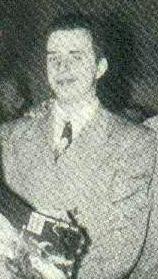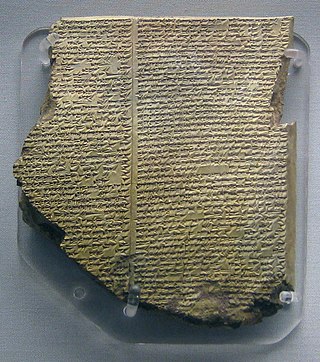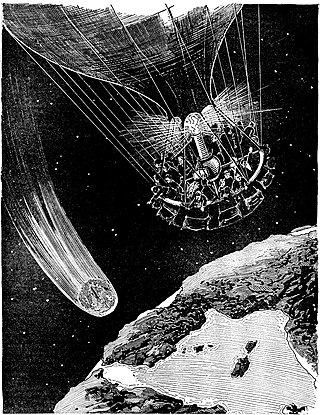Related Research Articles

Hugo Gernsback was an American editor and magazine publisher whose publications included the first science fiction magazine, Amazing Stories. His contributions to the genre as publisher were so significant that, along with the novelists Jules Verne and H. G. Wells, he is sometimes called "The Father of Science Fiction". In his honor, annual awards presented at the World Science Fiction Convention are named the "Hugos".

Mars, the fourth planet from the Sun, has appeared as a setting in works of fiction since at least the mid-1600s. Trends in the planet's portrayal have largely been influenced by advances in planetary science. It became the most popular celestial object in fiction in the late 1800s, when it became clear that there was no life on the Moon. The predominant genre depicting Mars at the time was utopian fiction. Around the same time, the mistaken belief that there are canals on Mars emerged and made its way into fiction, popularized by Percival Lowell's speculations of an ancient civilization having constructed them. The War of the Worlds, H. G. Wells's novel about an alien invasion of Earth by sinister Martians, was published in 1897 and went on to have a major influence on the science fiction genre.
Damien Francis Broderick is an Australian science fiction and popular science writer and editor of some 74 books. His science fiction novel The Dreaming Dragons (1980) introduced the trope of the generation time machine, his The Judas Mandala (1982) contains the first appearance of the term "virtual reality" in science fiction, and his 1997 popular science book The Spike was the first to investigate the technological singularity in detail.
George Edgar Slusser was an American scholar, professor and writer. Slusser was a well-known science fiction critic. A professor emeritus of comparative literature at University of California, Riverside, he was the first curator of the Eaton collection.

An extraterrestrial or alien is a lifeform that did not originate on Earth. The word extraterrestrial means "outside Earth". Extraterrestrials are a common theme in modern science-fiction, and also appeared in much earlier works such as the second-century parody True History by Lucian of Samosata.

Mind uploading—transferring an individual's personality to a computer—appears in several works of fiction. It is distinct from the concept of transferring a consciousness from one human body to another. It is sometimes applied to a single person and other times to an entire society. Recurring themes in these stories include whether the computerized mind is truly conscious, and if so, whether identity is preserved. It is a common feature of the cyberpunk subgenre, sometimes taking the form of digital immortality.

Jupiter, the largest planet in the Solar System, has appeared in works of fiction across several centuries. The way the planet has been depicted has evolved as more has become known about its composition; it was initially portrayed as being entirely solid, later as having a high-pressure atmosphere with a solid surface underneath, and finally as being entirely gaseous. It was a popular setting during the pulp era of science fiction. Life on the planet has variously been depicted as identical to humans, larger versions of humans, and non-human. Non-human life on Jupiter has been portrayed as primitive in some works and more advanced than humans in others.

Pluto has appeared in fiction as a setting since shortly after its 1930 discovery, albeit infrequently. It was initially comparatively popular as it was newly discovered and thought to be the outermost object of the Solar System and made more fictional appearances than either Uranus or Neptune, though still far fewer than other planets. Alien life, sometimes intelligent life and occasionally an entire ecosphere, is a common motif in fictional depictions of Pluto. Human settlement appears only sporadically, but it is often either the starting or finishing point for a tour of the Solar System. It has variously been depicted as an originally extrasolar planet, the remnants of a destroyed planet, or entirely artificial. Its moon Charon has also appeared in a handful of works.

Robert Augustine Ward "Doc" Lowndes was an American science fiction author, editor and fan. He was known best as the editor of Future Science Fiction, Science Fiction, and Science Fiction Quarterly, among many other crime-fiction, western, sports-fiction, and other pulp and digest sized magazines for Columbia Publications. Among the most famous writers he was first to publish at Columbia was mystery writer Edward D. Hoch, who in turn would contribute to Lowndes's fiction magazines as long as he was editing them. Lowndes was a principal member of the Futurians. His first story, "The Outpost at Altark" for Super Science in 1940, was written in collaboration with fellow Futurian Donald A. Wollheim, uncredited.

Neptune has appeared in fiction since shortly after its 1846 discovery, albeit infrequently. It initially made appearances indirectly—e.g. through its inhabitants—rather than as a setting. The earliest stories set on Neptune itself portrayed it as a rocky planet rather than as having its actual gaseous composition; later works rectified this error. Extraterrestrial life on Neptune is uncommon in fiction, though the exceptions have ranged from humanoids to gaseous lifeforms. Neptune's largest moon Triton has also appeared in fiction, especially in the late 20th century onwards.

Uranus has been used as a setting in works of fiction since shortly after its 1781 discovery, albeit infrequently. The earliest depictions portrayed it as having a solid surface, whereas later stories portrayed it more accurately as a gaseous planet. Its moons have also appeared in a handful of works. Both the planet and its moons have experienced a slight trend of increased representation in fiction over time.
Richard Neil Barron was a science fiction bibliographer and scholar. His training was as a librarian. He is perhaps best known for his book Anatomy of Wonder: A Critical Guide to Science Fiction. He won the Pilgrim Award for Lifetime Achievement in the field of science fiction scholarship in 1982. He died on September 5, 2010, in Las Vegas, Nevada.

The concepts of space stations and space habitats feature in science fiction. The difference between the two is that habitats are larger and more complex structures intended as permanent homes for substantial populations, but the line between the two is fuzzy with significant overlap and the term space station is sometimes used for both concepts. The first such artificial satellite in fiction was Edward Everett Hale's "The Brick Moon" in 1869, a sphere of bricks 61 meters across accidentally launched into orbit around the Earth with people still onboard.
Science fiction studies is the common name for the academic discipline that studies and researches the history, culture, and works of science fiction and, more broadly, speculative fiction.

Feminist literature is fiction, nonfiction, drama, or poetry, which supports the feminist goals of defining, establishing, and defending equal civil, political, economic, and social rights for women. It often identifies women's roles as unequal to those of men – particularly as regarding status, privilege, and power – and generally portrays the consequences to women, men, families, communities, and societies as undesirable.

Immortality is a common theme in fiction. The concept has been depicted since the Epic of Gilgamesh, the oldest known work of fiction. Originally appearing in the domain of mythology, it has later become a recurring element in the genres of horror, science fiction, and fantasy. For most of literary history, the dominant perspective has been that the desire for immortality is misguided, albeit strong; among the posited drawbacks are ennui, loneliness, and social stagnation. This view was challenged in the 20th century by writers such as George Bernard Shaw and Roger Zelazny. Immortality is commonly obtained either from supernatural entities or objects such as the Fountain of Youth or through biological or technological means such as brain transplants.

The Eaton Collection of Science Fiction and Fantasy, formerly known as the J. Lloyd Eaton Collection of Science Fiction, Fantasy, Horror, and Utopian Literature, is "the largest publicly accessible collection of science fiction, fantasy, horror and utopian and dystopian literature in the world". It is housed in Special Collections and Archives of the UCR Libraries at the University of California, Riverside. It consists of more than 300,000 items, including hardcover and paperback books, SF fanzines, film and visual material, and comic books, including manga and anime, as well as a variety of archival materials.

Comets have appeared in works of fiction since at least the 1830s. They primarily appear in science fiction as literal objects, but also make occasional symbolical appearances in other genres. In keeping with their traditional cultural associations as omens, they often threaten destruction to Earth. This commonly comes in the form of looming impact events, and occasionally through more novel means such as affecting Earth's atmosphere in different ways. In other stories, humans seek out and visit comets for purposes of research or resource extraction. Comets are inhabited by various forms of life ranging from microbes to vampires in different depictions, and are themselves living beings in some stories.
Recursive science fiction is a subgenre of science fiction, which itself takes the form of an exploration of science fiction within the narrative of the story.

Amazing Stories Annual was a pulp magazine which published a single issue in July 1927. It was edited by Hugo Gernsback, and featured the first publication of The Master Mind of Mars, by Edgar Rice Burroughs, which had been rejected by several other magazines, perhaps because the plot included a satire on religious fundamentalism. The other stories in Amazing Stories Annual were reprints, including two stories by A. Merritt, and one by H.G. Wells. The magazine sold out, and its success led Gernsback to launch Amazing Stories Quarterly the following year.
References
- 1 2 3 "Westfahl, Gary". Revised October 25, 2014. The Encyclopedia of Science Fiction (sf-encyclopedia.com). Retrieved 2014-12-20. Entry by 'GW/JC', Westfahl and editor John Clute.
- 1 2 3 4 "Gary Westfahl – Summary Bibliography". ISFDB. Retrieved 2014-12-20.
- ↑ Westfahl, Gary. "Orange County Apple and Other Aberrations" Archived 2012-10-23 at the Wayback Machine (bibliographic data). Los Angeles Times . February 3, 1991. Page BR11.
Tags: Science fiction & fantasy, Novels, Books-titles, Books-authors. (subscription required) - ↑ Westfahl, Gary. "What Science Fiction Leaves Out of the Future #2: The Day After Tomorrow". The Internet Review of Science Fiction. March 2009.
- ↑ de Lint, Charles. The Greenwood Encyclopedia of Science Fiction and Fantasy (book review). The Magazine of Fantasy and Science Fiction. April 1, 2006.
- ↑ Hassler, Donald M. (2005-12-22). "The Greenwood Encyclopedia of Science Fiction and Fantasy: Themes, Works, and Wonders". Extrapolation. 46 (4): 541–543.
- ↑ Han, Sallie. 2001 "A food fantast when sci-fi tries to give us a taste of the future, it's often rotten – and wrong". Daily News . December 31, 1997. [ dead link ]
- ↑ Erlich, Richard D. "The Mechanics of Wonder: The Creation of the Idea of Science Fiction" (review). Utopian Studies. March 22, 1999.
- ↑ Hintz, Carrie. "Science Fiction, Children's Literature and Popular Culture: Coming of Age in Fantasyland" (review). Utopian Studies. January 1, 2001.
- ↑ Abrash, Merritt. "Gary Westfahl and George Slusser, eds. Science Fiction, Canonization, Marginalization, and the Academy" (book review). Utopian Studies. March 22, 2002.
- ↑ "Jeremy Anson Westfahl | ps.uci.edu". ps.uci.edu. Archived from the original on 3 February 2015. Retrieved 22 May 2022.
- ↑ The Spacesuit Film: A History, 1918-1969
- ↑ http://www.accessmylibrary.com/coms2/summary_0286-2768918_ITM (book review). Utopian Studies. 2002.